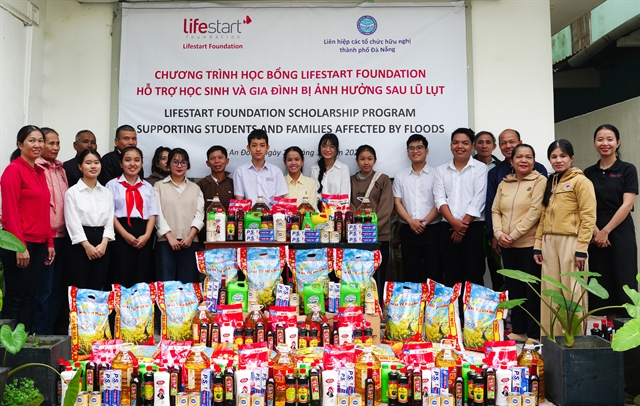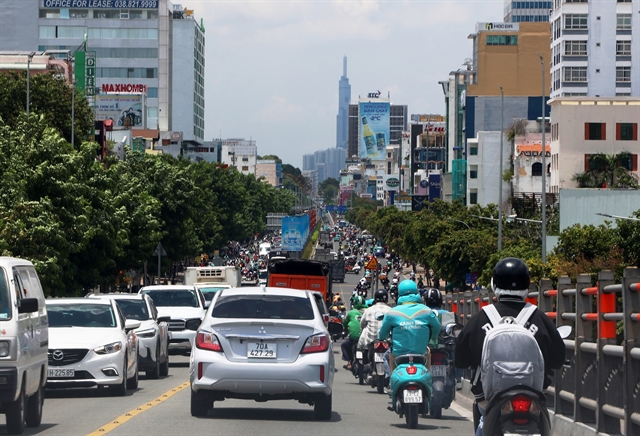 Economy
Economy

 |
| A construction site of an apartment project on Võ Văn Kiệt Street, Bình Tân District, HCM City. VNA/VNS Photo |
HÀ NỘI — Unfinished real estate inventory entangled in prolonged legal issues, limited access to capital, and products misaligned with market demand, have caused financial burdens for property developers.
Despite signs of recovery in the market, real estate inventory levels in the third quarter remained high. Notably, many reported inventory levels that consume up to 50 per cent of their registered capital, with some reporting this figure as high as nearly 80 per cent.
Novaland’s financial report showed that as of September 30, its inventory had risen by 4 per cent to VNĐ145 trillion (over US$5.7 billion), compared to VNĐ138.9 trillion at the end of 2023. The bulk of this inventory is attributed to construction in progress.
The company stated that around 40 per cent (nearly VNĐ58 trillion) is being used as collateral for loans.
As of the end of September, its total assets were over VNĐ232 trillion, marking a 4 per cent decrease. Thus, inventory now comprises more than half of the company’s total assets.
As of September 30, Đất Xanh Group's total assets reached VNĐ28.85 trillion, showing a slight increase from the beginning of the year. Inventory accounted for 48 per cent of total assets, around VNĐ13.83 trillion, with unfinished real estate making up more than VNĐ11.3 trillion and construction in progress nearing VNĐ716 billion.
In the southern market, Phát Đạt Real Estate reported total assets of over VNĐ22.6 trillion as of September 30, a 7 per cent increase year-on-year. Inventory reached nearly VNĐ12.9 trillion, constituting over 50 per cent of its total assets.
Nam Long Group’s inventory in the first nine months of 2024 grew by VNĐ3 trillion, or 17.3 per cent, compared to the end of last year, rising to over VNĐ20.37 trillion. Most of this inventory comprises unfinished real estate across 15 projects worth over VNĐ20.3 trillion, including prominent ones like Akari and Waterpoint Phase 2.
Additionally, project management services hold VNĐ59 billion and construction materials inventory is just over VNĐ4 billion.
By the end of September, the company’s total assets exceeded VNĐ29.82 trillion, up 3.91 per cent from the beginning of the year, with inventory comprising 68 per cent of its assets.
Another real estate player in HCM City, Khang Điền House, held nearly VNĐ22.5 trillion in inventory as of September 30, up from nearly VNĐ17.8 trillion at the end of last year, an increase of nearly 20 per cent. The increase is largely due to unfinished projects.
The largest of these is the Bình Trưng Đông project, valued at over VNĐ7.87 trillion, followed by the Tân Tạo Residential Area (VNĐ6.65 trillion), Phong Phú 2 Settlement Area (VNĐ1.8 trillion), An Dương Vương (VNĐ1.74 trillion), and Bình Hưng Residential Area 11A (over VNĐ1.72 trillion).
Khang Điền's total assets reached VNĐ31.6 trillion as of September 30, a 19 per cent increase from the end of 2023, with inventory levels approaching 80 per cent.
 |
| Buildings of Vinhomes Ocean Park 3 project in Hà Nội. Photo vin.city |
Among these property developers, Vinhomes reported the lowest inventory-to-asset ratio, at just over 10 per cent.
As of September 30, its total assets exceeded VNĐ524.6 trillion, up 18 per cent since the beginning of the year. Its largest asset component is short-term receivables at VNĐ187.1 trillion, a rise of VNĐ54.3 trillion since the start of the year, while inventory also rose by over VNĐ2.6 trillion to VNĐ58.23 trillion.
According to experts, the average inventory turnover of real estate companies was 659 days, spiking to 1,562 days in 2022 and 1,283 days in 2023.
A report by the Private Economic Development Board showed that some companies might take up to 149 years to clear their inventories.
Financial expert Nguyễn Trí Hiếu told VnBussiness that large inventories were less concerning for financially healthy companies that rely on their own capital. However, companies with high financial leverage would face significant debt burdens, and if liquidity issues arise, they would struggle.
Amid high inventory levels, many companies focused on releasing inventory into the market last quarter.
Phát Đạt’s representative said that despite a challenging market, the company’s top priority remained survival and growth, leading them to opt for asset sales to maintain cash flow and prepare for a new cycle.
Vinhomes reported that revenue and profit in the first nine months were primarily driven by project handovers at Vinhomes Ocean Parks 2 and 3, with additional revenue recorded from Vinhomes Royal Island. — VNS




